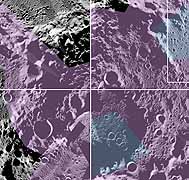| . |  |
. |
|
Austin - October 13, 1999 -  Efforts to find evidence of water on the moon came up dry, following the July 31 crash of the Lunar Prospector spacecraft into a deep crater in the southern lunar polar region University of Texas at Austin scientists announced Wednesday. But their research efforts have laid the groundwork for further investigations, as well as demonstrating a potentially useful new method for lunar prospecting.
Efforts to find evidence of water on the moon came up dry, following the July 31 crash of the Lunar Prospector spacecraft into a deep crater in the southern lunar polar region University of Texas at Austin scientists announced Wednesday. But their research efforts have laid the groundwork for further investigations, as well as demonstrating a potentially useful new method for lunar prospecting.The UT Austin group announced its findings at the annual meeting of the American Astronomical Society's Division for Planetary Sciences in Padua, Italy. In what was virtually a no-budget attempt to vaporize ice suspected to exist at the South Pole of the moon, NASA worked with engineers and astronomers at UT Austin to crash the space agency's successful Lunar Prospector spacecraft in a specific polar crater in a precise manner. The July 31 crash took only seconds. But the painstaking analysis of information recorded by more than a dozen professional Earth- and space-based telescopes required several months. Hundreds of amateur telescope owners also observed as the spacecraft plunged into a permanently shadowed crater near the pole. "As expected, we didn't make a big splash, or we all would have seen a water signal quickly," said Dr. David Goldstein, leader of the UT Austin team that proposed the crash. Goldstein, an aerospace engineer, is an associate professor in the UT Austin Department of Aerospace Engineering and Engineering Mechanics.
Last year, the Lunar Prospector team reported the spacecraft's instruments had revealed possible signs of frozen water at the moon's north and south poles. At that point, the UT Austin team came up with the idea of a controlled crash. "The way we aimed to detect water -- or its signature -- was through sensitive spectrometers tuned to look for the ultraviolet spectral emission lines expected from the hydroxyl (OH) molecules," said Barker. Barker and Shim analyzed the spectra from NASA's Hubble Space Telescope, McDonald telescope and the Keck I in Hawaii. Scientists and engineers working on the project knew from the beginning that there was a low probability of proving existence of water on the moon and the research discussed in Padua did not confirm water's existence. But the researchers said several benefits resulted from this potentially high-payoff experiment, including:
The team offered several possible reasons why the telescopic information has yielded no evidence of water, however, there is no way of knowing which of them might apply:
SPACE SCIENCE Tilting At Smashed Planets  Cameron Park - August 9, 1999 - It is now completely accepted that, during the formation of the Solar System, there was a long period during which large "proto planets" or "planetesimals" several hundred to several thousand kilometers across were sailing all over the Solar System and crashing into each other and into the gradually forming planets. Cameron Park - August 9, 1999 - It is now completely accepted that, during the formation of the Solar System, there was a long period during which large "proto planets" or "planetesimals" several hundred to several thousand kilometers across were sailing all over the Solar System and crashing into each other and into the gradually forming planets.
Lunar Prospector at SpaceDaily
|
| |||||||||
| The content herein, unless otherwise known to be public domain, are Copyright 1995-2016 - Space Media Network. All websites are published in Australia and are solely subject to Australian law and governed by Fair Use principals for news reporting and research purposes. AFP, UPI and IANS news wire stories are copyright Agence France-Presse, United Press International and Indo-Asia News Service. ESA news reports are copyright European Space Agency. All NASA sourced material is public domain. Additional copyrights may apply in whole or part to other bona fide parties. Advertising does not imply endorsement, agreement or approval of any opinions, statements or information provided by Space Media Network on any Web page published or hosted by Space Media Network. Privacy Statement All images and articles appearing on Space Media Network have been edited or digitally altered in some way. Any requests to remove copyright material will be acted upon in a timely and appropriate manner. Any attempt to extort money from Space Media Network will be ignored and reported to Australian Law Enforcement Agencies as a potential case of financial fraud involving the use of a telephonic carriage device or postal service. |